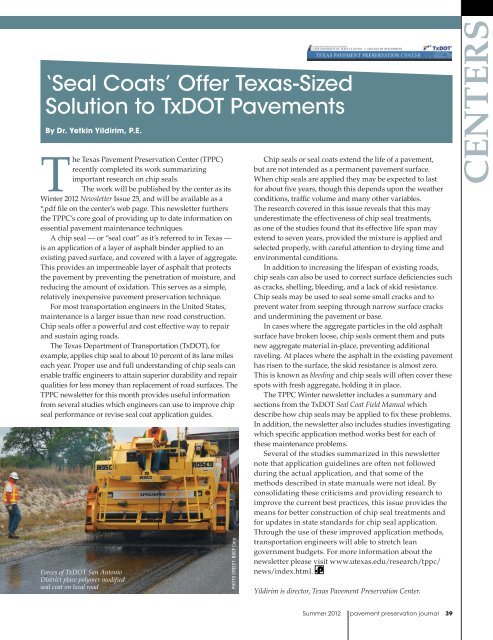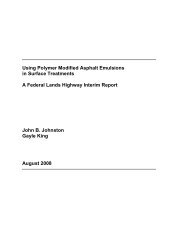journal - TSP2
journal - TSP2
journal - TSP2
You also want an ePaper? Increase the reach of your titles
YUMPU automatically turns print PDFs into web optimized ePapers that Google loves.
‘Seal Coats’ Offer Texas-Sized<br />
Solution to TxDOT Pavements<br />
By Dr. Yetkin Yildirim, P.E.<br />
The Texas Pavement Preservation Center (TPPC)<br />
recently completed its work summarizing<br />
important research on chip seals.<br />
The work will be published by the center as its<br />
Winter 2012 Newsletter Issue 25, and will be available as a<br />
*.pdf file on the center’s web page. This newsletter furthers<br />
the TPPC’s core goal of providing up to date information on<br />
essential pavement maintenance techniques.<br />
A chip seal — or “seal coat” as it’s referred to in Texas —<br />
is an application of a layer of asphalt binder applied to an<br />
existing paved surface, and covered with a layer of aggregate.<br />
This provides an impermeable layer of asphalt that protects<br />
the pavement by preventing the penetration of moisture, and<br />
reducing the amount of oxidation. This serves as a simple,<br />
relatively inexpensive pavement preservation technique.<br />
For most transportation engineers in the United States,<br />
maintenance is a larger issue than new road construction.<br />
Chip seals offer a powerful and cost effective way to repair<br />
and sustain aging roads.<br />
The Texas Department of Transportation (TxDOT), for<br />
example, applies chip seal to about 10 percent of its lane miles<br />
each year. Proper use and full understanding of chip seals can<br />
enable traffic engineers to attain superior durability and repair<br />
qualities for less money than replacement of road surfaces. The<br />
TPPC newsletter for this month provides useful information<br />
from several studies which engineers can use to improve chip<br />
seal performance or revise seal coat application guides.<br />
Forces of TxDOT San Antonio<br />
District place polymer modified<br />
seal coat on local road<br />
PHOTO CREDIT: BASF Corp.<br />
Chip seals or seal coats extend the life of a pavement,<br />
but are not intended as a permanent pavement surface.<br />
When chip seals are applied they may be expected to last<br />
for about five years, though this depends upon the weather<br />
conditions, traffic volume and many other variables.<br />
The research covered in this issue reveals that this may<br />
underestimate the effectiveness of chip seal treatments,<br />
as one of the studies found that its effective life span may<br />
extend to seven years, provided the mixture is applied and<br />
selected properly, with careful attention to drying time and<br />
environmental conditions.<br />
In addition to increasing the lifespan of existing roads,<br />
chip seals can also be used to correct surface deficiencies such<br />
as cracks, shelling, bleeding, and a lack of skid resistance.<br />
Chip seals may be used to seal some small cracks and to<br />
prevent water from seeping through narrow surface cracks<br />
and undermining the pavement or base.<br />
In cases where the aggregate particles in the old asphalt<br />
surface have broken loose, chip seals cement them and puts<br />
new aggregate material in-place, preventing additional<br />
raveling. At places where the asphalt in the existing pavement<br />
has risen to the surface, the skid resistance is almost zero.<br />
This is known as bleeding and chip seals will often cover these<br />
spots with fresh aggregate, holding it in place.<br />
The TPPC Winter newsletter includes a summary and<br />
sections from the TxDOT Seal Coat Field Manual which<br />
describe how chip seals may be applied to fix these problems.<br />
In addition, the newsletter also includes studies investigating<br />
which specific application method works best for each of<br />
these maintenance problems.<br />
Several of the studies summarized in this newsletter<br />
note that application guidelines are often not followed<br />
during the actual application, and that some of the<br />
methods described in state manuals were not ideal. By<br />
consolidating these criticisms and providing research to<br />
improve the current best practices, this issue provides the<br />
means for better construction of chip seal treatments and<br />
for updates in state standards for chip seal application.<br />
Through the use of these improved application methods,<br />
transportation engineers will able to stretch lean<br />
government budgets. For more information about the<br />
newsletter please visit www.utexas.edu/research/tppc/<br />
news/index.html.<br />
Yildirim is director, Texas Pavement Preservation Center.<br />
CENTERS<br />
Summer 2012 pavement preservation <strong>journal</strong> 39
















